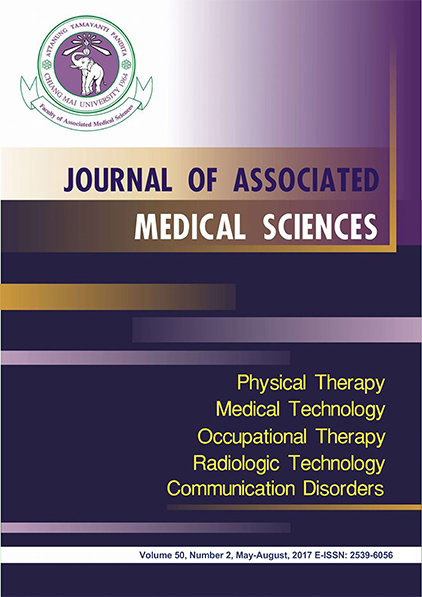Dose different between original treatment planning and planned adaptive calculation during helical tomotherapy in patients with nasopharyngeal cancer
Main Article Content
Abstract
Background: Changing anatomic and volumetric occur in nasopharyngeal cancer (NPC) patients during fractioned radiotherapy cause the delivered dose considerably different from the original plan.
Objectives: The study purpose was to evaluate dose difference between original plan and planned adaptive software calculation during the course of radiotherapy in NPC patients treated with Tomotherapy HiArtTM system.
Materials and methods: Three NPC patients treated with helical tomotherapy underwent daily positional correction using megavoltage CT imaging. Both parotid glands and spinal cord of patients were recontoured on daily MVCT images. MVCT images were used to recalculate dose distribution for all 33 fractions by planned adaptive software. The original plan dose and recalculate dose were compared.
Results: Percent dose difference between original plan and planned adaptive dose of PTV70 (D95%), left and right parotid glands (D50%) were 1.74%±0.32%, 35.19%±12.67% and 24.60%±15.21%, respectively. The structure dose difference were statistically significant (p<0.05) after fraction number 2nd, 8th and 7th, respectively. Percentage of spinal cord dose (D2%) difference between original plan and planned adaptive was 8.76%±10.15% with no statistically significance. Volume reduction in percentage of PTV70, left and right parotid glands volumes compare to original plan were 9.43%, 29.00% and 27.29%, respectively. Volume of spinal cord was not change during the treatments.
Conclusion: Anatomic and volumetric variations in nasopharyngeal cancer patients caused PTV70 and parotid glands in receiving treatment dose more than original plan. Adaptive planning should be considered to correct for delivery dose.
Journal of Associated Medical Sciences 2017; 50(2): 286-292. Doi: 10.14456/jams.2017.28
Article Details

This work is licensed under a Creative Commons Attribution-NonCommercial-NoDerivatives 4.0 International License.
Personal views expressed by the contributors in their articles are not necessarily those of the Journal of Associated Medical Sciences, Faculty of Associated Medical Sciences, Chiang Mai University.
References
2. Division of Therapeutic Radiation and Oncology, King Chulalongkorn Memorial Hospital [Internet]. Nasopharyngeal Cancer. 2017 [cited 2017 Mar 3]. Available from: http://www.chulacancer.net/patient-knowledge-inner.php?id=113
3. Loo H, Fairfoul J, Chakrabarti A, Dean JC, Benson RJ, Jefferies SJ, et al. Tumour shrinkage and contour change during radiotherapy increase the dose to organs at risk but not the target volumes for head and neck cancer patients treated on the Tomotherapy HiArt System. Clin Oncol 2011; 23: 40-7.
4. Langen KM, Papanikolaou N, Balog J, Crilly R, Followill D, Goddu S, et al. QA for helical tomotherapy: Report of the AAPM Radiation Therapy Committee Task Group 148 Medical Physics 2010; 37: 4817-53.
5. Meeks SL, Harmon JF, Langen KM, Willoughby TR, Wagner TH, Kupelian PA. Performance characterization of megavoltage computed tomography imaging on a helical tomotherapy unit. Med Phys 2005; 32(8): 2673-81.
6. Langen KM, Meeks SL, Poole DO, Wagner TH, Willoughby TR, Kupelian PA, et al. The use of megavoltage CT (MVCT) images for dose recomputations. Phys in Med and Biol 2005; 50: 4259-76.
7. Castadot P, Lee JA, Geets X, Gregoire V. Adaptive radiotherapy for head and neck cancer. Semin Radiat Oncol 2010; 20: 84-93.
8. Hansen EK, Bucci MK, Quivey JM, Weinberg V, Xia P. Repeat CT imaging and raplanning during the course of IMRT for head and neck cancer. Int J Radiat Oncol Biol phys 2006; 64(2): 355-62.
9. Park S, Cheong KH, Hwang TJ, Kang SK, Lee M, Kim KJ, et al. When should an adaptive plan be considered for head-and-neck cancer patients undergoing tomotherapy treatment? J Korean Phys soc 2010; 56(3): 897-904.
10. Yao WR, Xu SP, Liu B, Cao XT, Ren G, Du L, et al. Replanning Criteria and Timing Definition for Parotid Protection-Based Adaptive Radiation Therapy in Nasopharyngeal Carcinoma. Biomed Res Int. 2015; 2015: 1-8. http://dx.doi.org/10.1155/2015/47638
11. Han C, Chen YJ, Liu A, Schultheiss TE, Wong JYC. Actual dose variation of parotid glands and spinal cord for nasopharyngeal cancer patients during radiotherapy. Int J Radiat Oncol Biol phys 2008; 70(4): 1256-62.
12. Zhang X, Li M, Cao J, Luo JW, Xu GZ, Gao L, et al. Dosimetric variation of target volumes and organs at risk in nasopharyngeal carcinoma intensity-modulated radiotherapy. Br J Radiol 2012; 85: e506-e513.


